Hokarsar Wetland (Srinagar), May 8 (IANS): The sprawling wetlands in Kashmir have long served as nature’s first line of defence against an outbreak of violent floods the valley is so prone to. But the marshes are shrinking fast, increasing fears of a looming disaster similar to what it witnessed in 2014.
The decline has also robbed millions of Central Asian, Chinese and European winged visitors of their winter homes and habitat, posing an existential threat to the Valley’s fragile ecosystem.
Not only that. The economic importance of these wetlands has always been highly undervalued, experts told this correspondent.
“Wetlands all around the world matter a great deal to humans. Kashmir is no exception but we often fail to recognize their importance,” said Farooq Shah, a known green activist, who has been working and writing on Kashmir environment for the last nearly two decades.
Economic and environmental benefits apart, these wetlands also help offset terrible climate change impacts.Farooq Shah, Environmental Activist
According to official records, the wetlands have largely fallen prey to paddy cultivation, plantation, and residential complexes. Shah attributed it to the human greed and an official apathy.
Official records reveal that nine Kashmir wetlands, despite being protected legally, have shrunk a great deal over the last 50 years.
High pollution levels and blatant encroachments have wreaked havoc with its natural vegetation, leaving thousands of farmers in the lurch.
The growth of unwanted weeds, accumulation of silt, human and solid waste has drastically affected the growth of fish, water nuts and vegetables like lotus stems, officials said.
Imtiyaz Ahmad Lone, a wildlife warden, who looks after Hokarsar, blamed Jhelum flood basin for the “the devastation” because it “brings heavy volumes of silt and pollutants”.
Besides, “some industry houses have also been found dumping waste” on the wetland peripheries which have become permanent grazing sites for cattle and “dumping ground for household and industrial trash”, he said.
The official said he personally has been persistently seeking a dredging machine to clear unwanted weeds.
I have been requesting the government to give me the machine for a few months. Got a negative response.Imtiyaz Ahmad Lone, Wildlife Warden
He claimed the department has been acting tough against encroachers and, so far, more than 400 cases have been registered. He would not comment on a prosecution rate.
Shah, the environmentalist, said another flood in the valley would be more disastrous than in 2014 when large parts of Srinagar remained inundated for weeks together.
We’ve sown the seeds of destruction and we’re just reaping the bitter fruit now. We lack a sense of ownership that largely has come from the instability in the region.Imtiyaz Ahmad Lone, Wildlife Warden
(Javaid Trali is a Srinagar-based freelance journalist. He can be contacted at atharjavaid55@gmail.com)
(At The Quint, we question everything. Play an active role in shaping our journalism by becoming a member today.)
